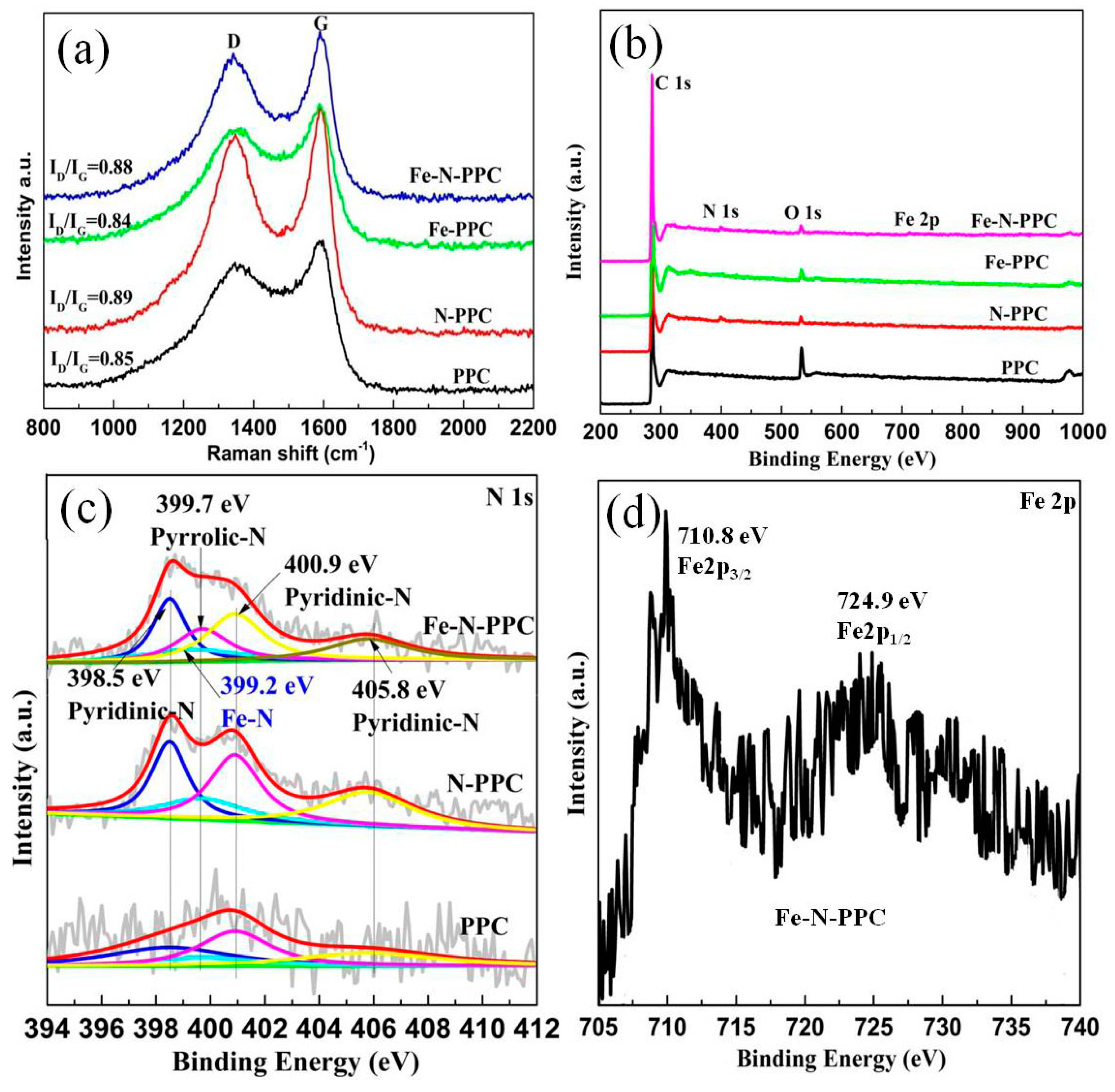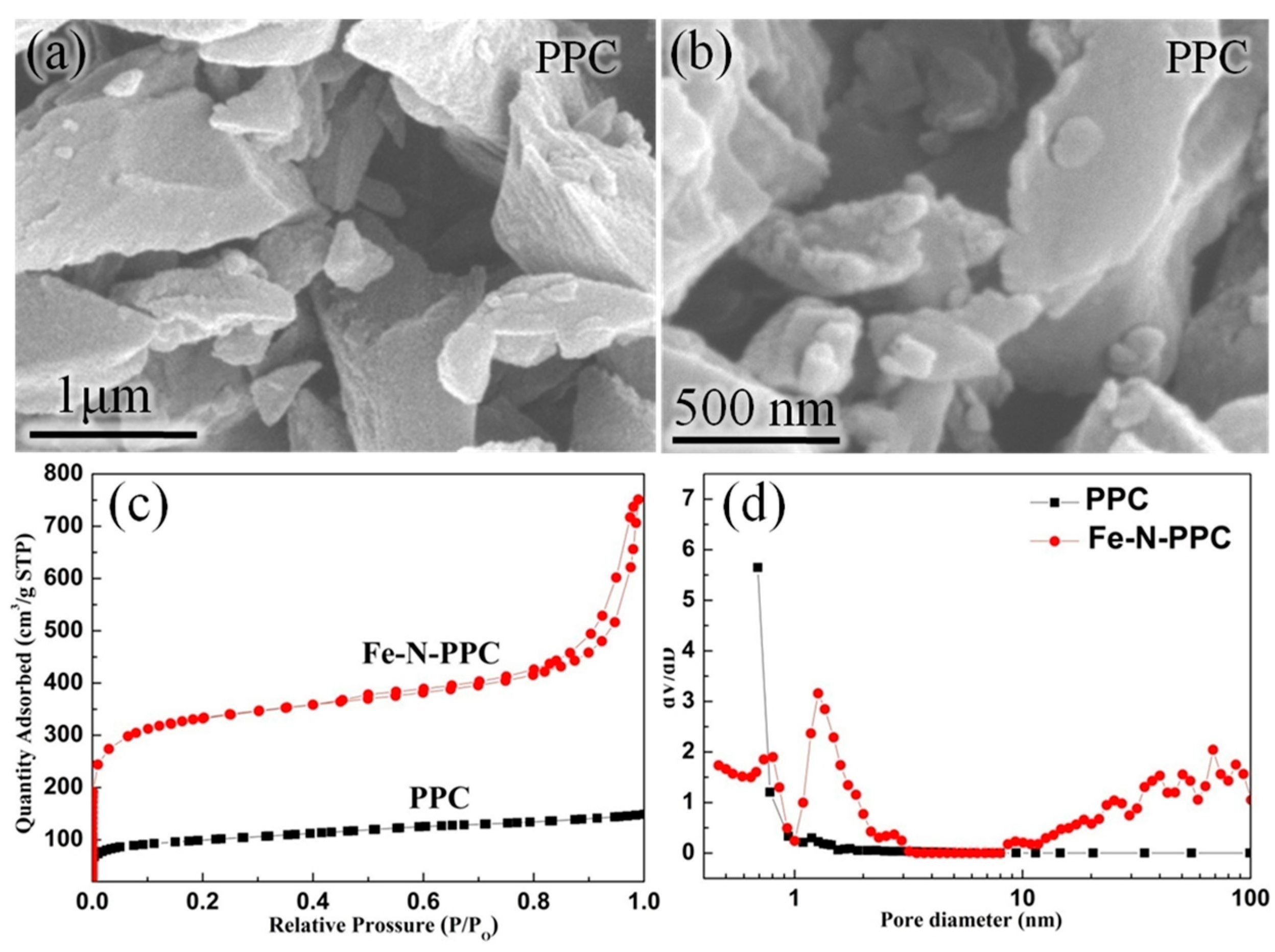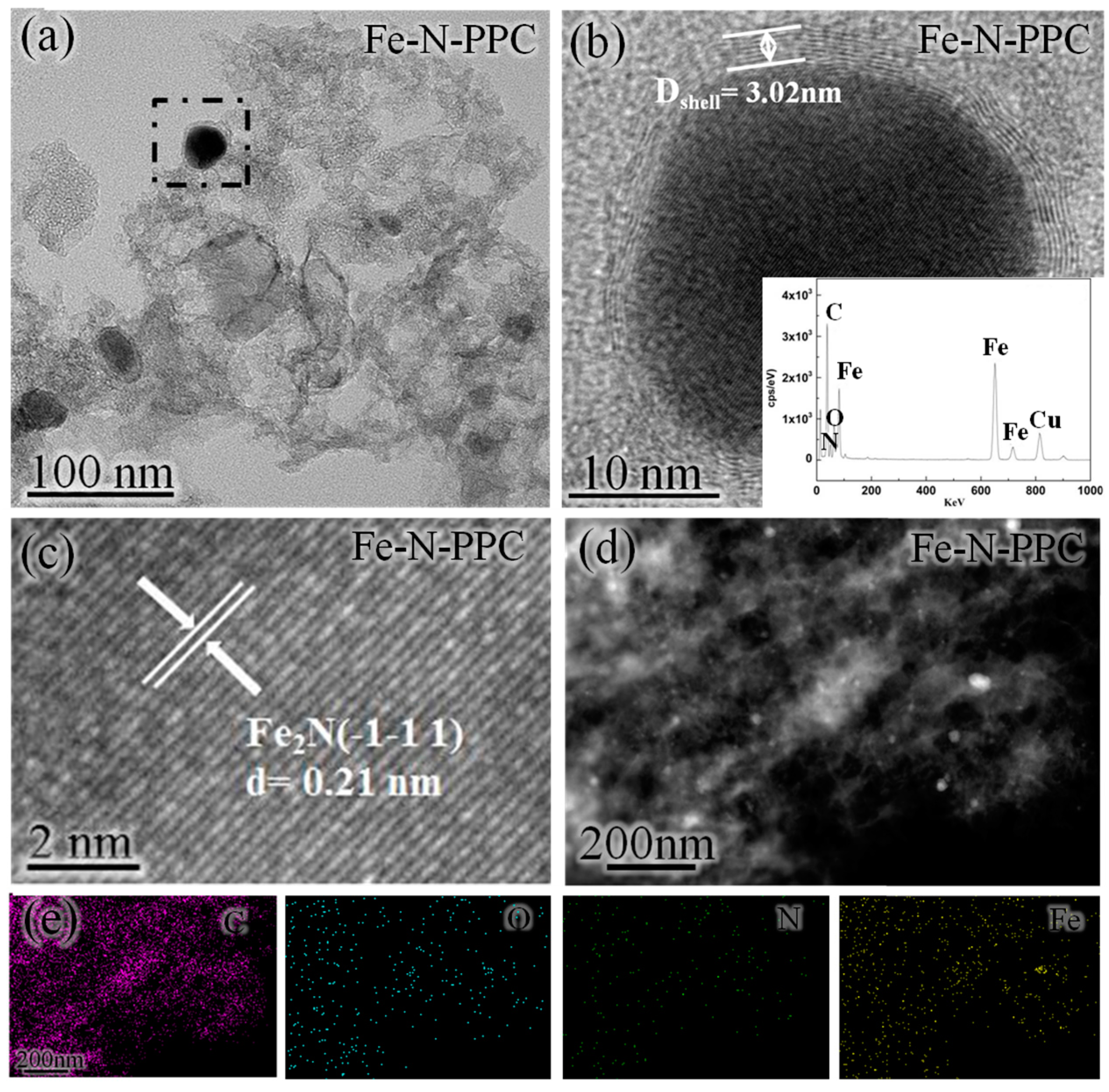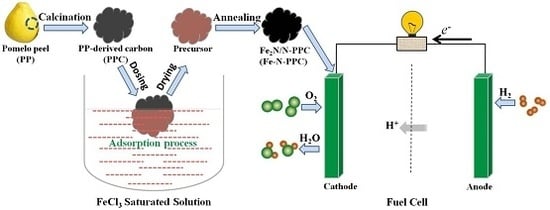Enhanced Oxygen Reduction Reaction by In Situ Anchoring Fe2N Nanoparticles on Nitrogen-Doped Pomelo Peel-Derived Carbon
Abstract
:1. Introduction
2. Results and Discussion
3. Materials and Methods
3.1. Synthesis of Samples
3.2. Characterization
3.3. Electrochemical Measurements
4. Conclusions
Acknowledgments
Author Contributions
Conflicts of Interest
References
- Borghei, M.; Laocharoen, N.; Kibena-Põldsepp, E.; Johansson, L.S.; Campbell, J.; Kauppinen, E.; Tammeveski, K.; Rojas, O.J. Porous N,P-doped carbon from coconut shells with high electrocatalytic activity for oxygen reduction: Alternative to Pt-C for alkaline fuel cells. Appl. Catal. B Environ. 2017, 204, 394–402. [Google Scholar] [CrossRef]
- Wang, Y.; Zhu, M.; Li, Y.; Zhang, M.; Xue, X.; Shi, Y.; Dai, B.; Guo, X.; Yu, F. Heteroatom-doped porous carbon from methyl orange dye wastewater for oxygen reduction. Green Energy Environ. 2017. [Google Scholar] [CrossRef]
- Shi, L.; Wu, T.; Wang, Y.; Zhang, J.; Wang, G.; Zhang, J.; Dai, B.; Yu, F. Nitrogen-Doped Carbon Nanoparticles for Oxygen Reduction Prepared via a Crushing Method Involving a High Shear Mixer. Materials 2017, 10, 1030. [Google Scholar] [CrossRef] [PubMed]
- Guo, Z.; Xiao, Z.; Ren, G.; Xiao, G.; Zhu, Y.; Dai, L.; Jiang, L. Natural tea-leaf-derived, ternary-doped 3D porous carbon as a high-performance electrocatalyst for the oxygen reduction reaction. Nano Res. 2016, 9, 1244–1255. [Google Scholar] [CrossRef]
- Gao, S.; Li, X.; Li, L.; Wei, X. A versatile biomass derived carbon material for oxygen reduction reaction, supercapacitors and oil/water separation. Nano Energy 2017, 33, 334–342. [Google Scholar] [CrossRef]
- Gao, S.; Wei, X.; Fan, H.; Li, L.; Geng, K.; Wang, J. Nitrogen-doped carbon shell structure derived from natural leaves as a potential catalyst for oxygen reduction reaction. Nano Energy 2015, 13, 518–526. [Google Scholar] [CrossRef]
- Tong, J.; Wang, W.; Li, Q.; Liu, F.; Ma, W.; Li, W.; Su, B.; Lei, Z.; Bo, L. Composite of FeCo alloy embedded in biocarbon derived from eggshell membrane with high performance for oxygen reduction reaction and supercapacitor. Electrochim. Acta 2017, 248, 388–396. [Google Scholar] [CrossRef]
- Xuan, C.; Wu, Z.; Lei, W.; Wang, J.; Guo, J.; Wang, D. Nitrogen-Doped Hierarchical Porous Carbons Derived from Sodium Alginate as Efficient Oxygen Reduction Reaction Electrocatalysts. ChemCatChem 2017, 9, 809–815. [Google Scholar] [CrossRef]
- Li, Y.; Liu, J.; Yuan, Q.; Tang, H.; Yu, F.; Lv, X. A green adsorbent derived from banana peel for highly effective removal of heavy metal ions from water. RSC Adv. 2016, 6, 45041–45048. [Google Scholar] [CrossRef]
- Wang, C.; Xiong, Y.; Wang, H.; Jin, C.; Sun, Q. Naturally three-dimensional laminated porous carbon network structured short nano-chains bridging nanospheres for energy storage. J. Mater. Chem. A 2017, 5, 15759–15770. [Google Scholar] [CrossRef]
- Liu, B.; Zhang, L.; Qi, P.; Zhu, M.; Wang, G.; Ma, Y.; Guo, X.; Chen, H.; Zhang, B.; Zhao, Z.; et al. Nitrogen-Doped Banana Peel–Derived Porous Carbon Foam as Binder-Free Electrode for Supercapacitors. Nanomaterials 2016, 6, 18. [Google Scholar] [CrossRef] [PubMed]
- Yuan, W.; Feng, Y.; Xie, A.; Zhang, X.; Huang, F.; Li, S.; Zhang, X.; Shen, Y. Nitrogen-doped nanoporous carbon derived from waste pomelo peel as a metal-free electrocatalyst for the oxygen reduction reaction. Nanoscale 2016, 8, 8704–8711. [Google Scholar] [CrossRef] [PubMed]
- Xu, D.; Tong, Y.; Yan, T.; Shi, L.; Zhang, D. N,P-Codoped Meso-/Microporous Carbon Derived from Biomass Materials via a Dual-Activation Strategy as High-Performance Electrodes for Deionization Capacitors. ACS Sustain. Chem. Eng. 2017, 5, 5810–5819. [Google Scholar] [CrossRef]
- Liang, Q.; Ye, L.; Huang, Z.-H.; Xu, Q.; Bai, Y.; Kang, F.; Yang, Q.-H. A honeycomb-like porous carbon derived from pomelo peel for use in high-performance supercapacitors. Nanoscale 2014, 6, 13831–13837. [Google Scholar] [CrossRef] [PubMed]
- Argun, M.E.; Güclü, D.; Karatas, M. Adsorption of Reactive Blue 114 dye by using a new adsorbent: Pomelo peel. J. Ind. Eng. Chem. 2014, 20, 1079–1084. [Google Scholar] [CrossRef]
- Wang, H.; Yin, F.-X.; Chen, B.-H.; He, X.-B.; Lv, P.-L.; Ye, C.-Y.; Liu, D.-J. ZIF-67 incorporated with carbon derived from pomelo peels: A highly efficient bifunctional catalyst for oxygen reduction/evolution reactions. Appl. Catal. B Environ. 2017, 205, 55–67. [Google Scholar] [CrossRef]
- Ma, M.; You, S.; Wang, W.; Liu, G.; Qi, D.; Chen, X.; Qu, J.; Ren, N. Biomass-Derived Porous Fe3C/Tungsten Carbide/Graphitic Carbon Nanocomposite for Efficient Electrocatalysis of Oxygen Reduction. ACS Appl. Mater. Interfaces 2016, 8, 32307–32316. [Google Scholar] [CrossRef] [PubMed]
- Shao, M.; Chang, Q.; Dodelet, J.-P.; Chenitz, R. Recent Advances in Electrocatalysts for Oxygen Reduction Reaction. Chem. Rev. 2016, 116, 3594–3657. [Google Scholar] [CrossRef] [PubMed]
- Guo, D.; Shibuya, R.; Akiba, C.; Saji, S.; Kondo, T.; Nakamura, J. Active sites of nitrogen-doped carbon materials for oxygen reduction reaction clarified using model catalysts. Science 2016, 351, 361–365. [Google Scholar] [CrossRef] [PubMed]
- Xiao, J.; Xu, Y.; Xia, Y.; Xi, J.; Wang, S. Ultra-small Fe2N nanocrystals embedded into mesoporous nitrogen-doped graphitic carbon spheres as a highly active, sTable, and methanol-tolerant electrocatalyst for the oxygen reduction reaction. Nano Energy 2016, 24, 121–129. [Google Scholar] [CrossRef]
- Fu, S.; Zhu, C.; Song, J.; Du, D.; Lin, Y. Metal-Organic Framework-Derived Non-Precious Metal Nanocatalysts for Oxygen Reduction Reaction. Adv. Energy Mater. 2017, 7, 1700363. [Google Scholar] [CrossRef]
- Wang, M.-Q.; Yang, W.-H.; Wang, H.-H.; Chen, C.; Zhou, Z.-Y.; Sun, S.-G. Pyrolyzed Fe–N–C Composite as an Efficient Non-precious Metal Catalyst for Oxygen Reduction Reaction in Acidic Medium. ACS Catal. 2014, 4, 3928–3936. [Google Scholar] [CrossRef]
- Xia, W.; Mahmood, A.; Liang, Z.; Zou, R.; Guo, S. Earth-Abundant Nanomaterials for Oxygen Reduction. Angew. Chem. Int. Ed. 2016, 55, 2650–2676. [Google Scholar] [CrossRef] [PubMed]
- Wang, M.; Yang, Y.; Liu, X.; Pu, Z.; Kou, Z.; Zhu, P.; Mu, S. The role of iron nitrides in the Fe–N–C catalysis system towards the oxygen reduction reaction. Nanoscale 2017, 9, 7641–7649. [Google Scholar] [CrossRef] [PubMed]
- Yin, H.; Zhang, C.; Liu, F.; Hou, Y. Hybrid of Iron Nitride and Nitrogen-Doped Graphene Aerogel as Synergistic Catalyst for Oxygen Reduction Reaction. Adv. Funct. Mater. 2014, 24, 2930–2937. [Google Scholar] [CrossRef]
- Tang, C.; Zhang, Q. Nanocarbon for Oxygen Reduction Electrocatalysis: Dopants, Edges, and Defects. Adv. Mater. 2017, 29, 1604103. [Google Scholar] [CrossRef] [PubMed]
- Liu, X.; Dai, L. Carbon-based metal-free catalysts. Nat. Rev. Mater. 2016, 1, 16064. [Google Scholar] [CrossRef]
- Wang, D.; Astruc, D. The recent development of efficient Earth-abundant transition-metal nanocatalysts. Chem. Soc. Rev. 2017, 46, 816–854. [Google Scholar] [CrossRef] [PubMed]
- Liu, L.; Yang, X.; Ma, N.; Liu, H.; Xia, Y.; Chen, C.; Yang, D.; Yao, X. Scalable and Cost-Effective Synthesis of Highly Efficient Fe2N-Based Oxygen Reduction Catalyst Derived from Seaweed Biomass. Small 2016, 12, 1295–1301. [Google Scholar] [CrossRef] [PubMed]
- Zhou, M.; Wang, H.-L.; Guo, S. Towards high-efficiency nanoelectrocatalysts for oxygen reduction through engineering advanced carbon nanomaterials. Chem. Soc. Rev. 2016, 45, 1273–1307. [Google Scholar] [CrossRef] [PubMed]
- Liu, X.; Zou, S.; Chen, S. Ordered mesoporous carbons codoped with nitrogen and iron as effective catalysts for oxygen reduction reaction. Nanoscale 2016, 8, 19246–19255. [Google Scholar] [CrossRef] [PubMed]
- Wang, J.-G.; Liu, H.; Liu, H.; Fu, Z.; Nan, D. Facile synthesis of microsized MnO/C composites with high tap density as high performance anodes for Li-ion batteries. Chem. Eng. J. 2017, 328, 591–598. [Google Scholar] [CrossRef]
- Huang, X.; Yang, Z.; Dong, B.; Wang, Y.; Tang, T.; Hou, Y. In situ Fe2N@N-doped porous carbon hybrids as superior catalysts for oxygen reduction reaction. Nanoscale 2017, 9, 8102–8106. [Google Scholar] [CrossRef] [PubMed]
- Cao, L.; Li, Z.-H.; Gu, Y.; Li, D.-H.; Su, K.-M.; Yang, D.-J.; Cheng, B.-W. Rational design of N-doped carbon nanobox-supported Fe/Fe2N/Fe3C nanoparticles as efficient oxygen reduction catalysts for Zn–air batteries. J. Mater. Chem. A 2017, 5, 11340–11347. [Google Scholar] [CrossRef]
- Jiang, W.-J.; Gu, L.; Li, L.; Zhang, Y.; Zhang, X.; Zhang, L.-J.; Wang, J.-Q.; Hu, J.-S.; Wei, Z.; Wan, L.-J. Understanding the High Activity of Fe-N-C Electrocatalysts in Oxygen Reduction: Fe/Fe3C Nanoparticles Boost the Activity of Fe-NX. J. Am. Chem. Soc. 2016, 138, 3570–3578. [Google Scholar] [CrossRef] [PubMed]
- Wang, J.-G.; Zhang, Z.; Zhang, X.; Yin, X.; Li, X.; Liu, X.; Kang, F.; Wei, B. Cation exchange formation of prussian blue analogue submicroboxes for high-performance Na-ion hybrid supercapacitors. Nano Energy 2017, 39, 647–653. [Google Scholar] [CrossRef]
- Wang, L.; Yin, J.; Zhao, L.; Tian, C.; Yu, P.; Wang, J.; Fu, H. Ion-exchanged route synthesis of Fe2N-N-doped graphitic nanocarbons composite as advanced oxygen reduction electrocatalyst. Chem. Commun. 2013, 49, 3022–3024. [Google Scholar] [CrossRef] [PubMed]
- Jiang, H.; Li, C.; Shen, H.; Liu, Y.; Li, W.; Li, J. Supramolecular gel-assisted synthesis Co2P particles anchored in multielement co-doped graphene as efficient bifunctional electrocatalysts for oxygen reduction and evolution. Electrochim. Acta 2017, 231, 344–353. [Google Scholar] [CrossRef]
- An, L.; Zhu, M.; Dai, B.; Yu, F. Hollow palladium–copper bimetallic nanospheres with high oxygen reduction activity. Electrochim. Acta 2015, 176, 222–229. [Google Scholar] [CrossRef]





| Samples | C | N | O | Fe |
|---|---|---|---|---|
| PPC | 90.94 | ≈0 | 9.06 | - |
| N-PPC | 96.39 | 1.61 | 2.01 | - |
| Fe-PPC | 96.21 | - | 3.27 | 0.53 |
| Fe-N-PPC | 95.86 | 1.60 | 2.21 | 0.43 |
| Samples | Pyridinic | Fe-N | Pyrrolic | Graphitic | Oxidized |
|---|---|---|---|---|---|
| PPC | 25.9 | - | 15.0 | 34.5 | 24.6 |
| N-PPC | 31.9 | - | 10.8 | 32.2 | 25.1 |
| Fe-N-PPC | 32.2 | 9.0 | 12.8 | 33.6 | 12.4 |
| Sample | SBET (m2·g−1) | DBJH (nm) | Pore Volume (cm3·g−1) |
|---|---|---|---|
| PPC | 353.05 | 2.60 | 0.23 |
| Fe-N-PPC | 1103.90 | 3.48 | 0.96 |
| Catalysts | Raw Materials | Onset Potential (V vs. RHE) | Half-Wave Potential (V vs. RHE) | Stability Result (%) | Methanol Tolerance Result (%) | Reference |
|---|---|---|---|---|---|---|
| ZIF-67@NPC-2 | Pomelo peel, cobalt(II) acetate, methyl-imidazole | 0.89 | 0.82 | 82.0 (6000 s) | 95.7 (3 M) | [16] |
| Fe3C/WC/GC | Pomelo peel, K4Fe(CN)6, Na2WO4 | - | - | - | - | [17] |
| Fe2N/MNGCS | Dopamine, NH3·H2O | 0.881 | - | 95.2 (60,000 s) | 70.7 (4 M) | [20] |
| FeGH-ArNH3 | Fe3O4, histidine, Fe(NO3)3·9H2O, d-glucose | 0.80 | - | 94.4 (6000s) | >Pt/C | [24] |
| FexN/NGA | GO, iron (II) phthalocyanine | >Pt/C | - | 91.0 (20,000 s) | ~100 | [25] |
| Fe2N/N-GAs-20 | FeCl3·6H2O, sodium alginate, graphene | 1.02 | 0.93 | 90.0 (9 h) | ~100 | [29] |
| Fe2N@NPC-500 | 1,3,5-benzenetricarboxlic acid, N,N-Dimethylformamide, Fe(NO3)3·3H2O | 0.93 | 0.79 | 90.0 (25,000 s) | ~100 | [33] |
| Fe–N-CNBs | FeCl3, fructose, magnesium powder, magnesium ribbon | 1.03 | 0.875 | 83.0 (30,000 s) | ~100 | [34] |
| Fe2N/NGC-1000 | FeCl2, polyacrylic weak-acid cation-exchanged resin | 0.83 | 0.95 | - | - | [37] |
| Fe-N-PPC | Pomelo peel, FeCl3·6H2O, ammonia | 0.966 | 0.891 | 79.6 (20,000 s) | 97.2 (3 M) | This work |
© 2017 by the authors. Licensee MDPI, Basel, Switzerland. This article is an open access article distributed under the terms and conditions of the Creative Commons Attribution (CC BY) license (http://creativecommons.org/licenses/by/4.0/).
Share and Cite
Wang, Y.; Zhu, M.; Wang, G.; Dai, B.; Yu, F.; Tian, Z.; Guo, X. Enhanced Oxygen Reduction Reaction by In Situ Anchoring Fe2N Nanoparticles on Nitrogen-Doped Pomelo Peel-Derived Carbon. Nanomaterials 2017, 7, 404. https://doi.org/10.3390/nano7110404
Wang Y, Zhu M, Wang G, Dai B, Yu F, Tian Z, Guo X. Enhanced Oxygen Reduction Reaction by In Situ Anchoring Fe2N Nanoparticles on Nitrogen-Doped Pomelo Peel-Derived Carbon. Nanomaterials. 2017; 7(11):404. https://doi.org/10.3390/nano7110404
Chicago/Turabian StyleWang, Yiqing, Mingyuan Zhu, Gang Wang, Bin Dai, Feng Yu, Zhiqun Tian, and Xuhong Guo. 2017. "Enhanced Oxygen Reduction Reaction by In Situ Anchoring Fe2N Nanoparticles on Nitrogen-Doped Pomelo Peel-Derived Carbon" Nanomaterials 7, no. 11: 404. https://doi.org/10.3390/nano7110404






